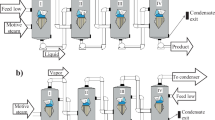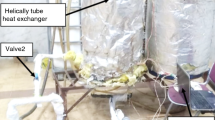Abstract
A dynamic approach for the modeling, simulation and analysis of no-frost Refrigerator (RF) is discussed. In Part I, the complex interactions among the components in the cooling system are analyzed in detail, based on which the modeling simplifications are proposed. Then, the mathematical models for the evaporator, cabinet and duct-fan are presented. The whole system is divided into two subsystems—refrigerant cycling system and air cycling system. In order to simplify the model, two closed-loop systems are broken into the compressor component and the evaporator component, respectively. A general distributed parameter model is employed for evaporator with homogeneous flow to simplify the two-phase evaporating flow region. The z-transfer function model is used to describe the cabinet load. Computational fluid dynamics (CFD) method is employed to obtain the pressure drop and flow rate curve of the duct-fan model.
Similar content being viewed by others
Abbreviations
- a, a i :
-
Coefficient of the equations
- A :
-
Area, m2
- b, b i :
-
Coefficient of the equations
- c p :
-
Specific heat capacity at constant pressure, J/(kg·K)
- C :
-
Thermal capacity, J/K
- D :
-
Diameter, m
- h :
-
Specific enthalpy, J/kg
- L :
-
Length or thickness, m
- p :
-
Pressure, Pa
- q m :
-
Mass flow rate, kg/s
- Q :
-
Heat transfer rate, W
- T :
-
Temperature, K
- u :
-
Velocity, m/s
- V :
-
Volume, m3
- -x :
-
Average mass quality
- α :
-
Heat convection coefficient, W/(m2.K)
- β :
-
Thermal leakage factor, W/(m.K)
- η :
-
Length along the air flow direction, m
- θ :
-
Temperature, °C
- µ :
-
Dynamic viscosity, kg/(m·s)
- ξ :
-
Length along the tube, m
- ρ :
-
Density, kg/m
- τ :
-
Time, s
- a, as:
-
Air, air side
- am:
-
Ambient
- eff:
-
Effective
- f:
-
Refrigerant, refrigerant side
- in:
-
Inside
- l:
-
Liquid
- v:
-
Vapor
- w:
-
Tube wall
References
Chi J, Didion D A. A simulation model of the transient performance of a heat pump [J]. International Journal of Refrigeration, 1982, 5(3): 176–184.
Macarthur J W. Transient heat pump behavior: A theoretical investigation [J]. International Journal of Refrigeration, 1984, 7(2): 123–132.
Sami S M, Dahmani A. Numerical prediction of dynamic performance of vapour-compression heat pump using new HFC alternatives to HCFC-22 [J]. Applied Thermal Engineering, 1996, 16(8/9): 691–705.
Wang H, Wang S. A mechanistic model of a centrifugal chiller to study HVAC dynamics [J]. Building services engineering research and technology, 2000, 21(2): 73–83.
Brown M W, Bansal P K. Transient simulation of vapour-compression packaged liquid chillers [J]. International Journal of Refrigeration, 2002, 25(5): 597–610.
Fu L, Ding G L, Zhang C L. Dynamic simulation of air-to-water dual-mode heat pump with screw compressor [J]. Applied Thermal Engineering, 2003, 23(13): 1629–1645.
Chen Z J, Lin W H. Dynamic simulation and optimal matching of a small-scale refrigeration system [J]. International Journal of Refrigeration, 1991, 14(4): 329–335.
Ploug-Sorensen L, Fredsted J P, Williatzen M. Improvements in the modelling and simulation of refrigeration system: aerospace tools applied to domestic refrigerator [J]. International Journal of HVAC & R Research, 1997, 3(4): 387–403.
Ding G L. Researches on the dynamic simulation and optimization of small-scale refrigeration appliances [D]. Shanghai: Shanghai Jiaotong University, 1993 (in Chinese).
Zhang C L. Fundamental study on the model-based intelligent simulation methodologies of refrigeration and air-conditioning appliances [D]. Shanghai: Shanghai Jiaotong University, 1999 (in Chinese).
Ding G L, Zhang C L, Lu Z L. Dynamic simulation of natural convection bypass two-circuit cycle refrigerator-freezer and its application. Part I. Component models [J]. Applied Thermal Engineering, 2004, 24(10): 1513–1524.
Lu Z L, Ding G L, Zhang C L. Dynamic simulation of natural convection bypass two-circuit cycle refrigerator-freezer and its application. Part II. System simulation and application [J]. Applied Thermal Engineering, 2004, 24(10): 1525–1533.
Bansal P K, Wich T, Browne M W. Optimization of egg-crate type evaporators in domestic refrigerators [J]. Applied Thermal engineering, 2001, 21(7): 751–770.
Wang H, Touber S. Distributed and non-steady-state modeling of an air cooler [J]. International Journal of Heat Mass Transfer, 1991, 14(2): 98–111.
Shih Y C. Numerical study of heat transfer performance on the air side of evaporator for a domestic refrigerator [J]. Numerical Heat Transfer. Part A, 2003, 44(3): 851–870.
Author information
Authors and Affiliations
Corresponding author
Rights and permissions
About this article
Cite this article
Su, Xp., Chen, Jp., Chen, Zj. et al. Dynamic simulation and performance investigation of no-frost refrigerator: Part I mathematical model. J. Shanghai Jiaotong Univ. (Sci.) 14, 40–44 (2009). https://doi.org/10.1007/s12204-009-0040-4
Received:
Published:
Issue Date:
DOI: https://doi.org/10.1007/s12204-009-0040-4




